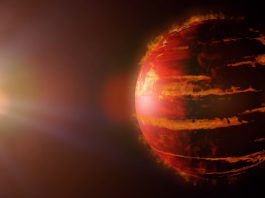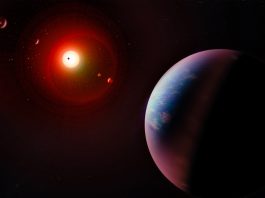Researchers predict that there are likely many planets like Earth that have formed around other stars in the Milky Way.
Scientists have examined countless exoplanets with the goal of discovering alien civilisations. However, in order for a planet to have life, liquid water must be present. The chances of finding ‘wet planets’ have seemed impossible to calculate because it has been the assumption that planets like Earth get their water by chance if a large, ice asteroid hits the planet.
Researchers from the GLOBE Institute at the University of Copenhagen, Denmark, have published an eye-opening study, indicating that water may be present during the very formation of a planet. According to the study’s calculations, this is true for Earth, Venus, and Mars.
Professor Anders Johansen from the Centre for Star and Planet Formation who has led the study that is published in the journal Science Advances, said: “All our data suggest that water was part of Earth’s building blocks, right from the beginning. And because the water molecule is frequently occurring, there is a reasonable probability that it applies to all planets in the Milky Way. The decisive point for whether liquid water is present is the distance of the planet from its star.”
The pebble accretion theory
Using a computer model, Johansen and his team have calculated how quickly planets are formed, and from which building blocks. The study indicates that it was millimetre-sized dust particles of ice and carbon, which are known to orbit around all young stars in the Milky Way.
Johansen said: “Up to the point where Earth had grown to 1% of its current mass, our planet grew by capturing masses of pebbles filled with ice and carbon. Earth then grew faster and faster until, after five million years, it became as large as we know it today. Along the way, the temperature on the surface rose sharply, causing the ice in the pebbles to evaporate on the way down to the surface so that, today, only 0.1% of the planet is made up of water, even though 70% of Earth’s surface is covered by water.”
The team’s theory, called ‘pebble accretion’, is that planets are formed by pebbles that are clumping together, and that the planets then grow larger and larger. H2O is found everywhere in our galaxy, and the theory therefore opens up the possibility that other planets may have been formed in the same way as Earth, Mars, and Venus.
Johansen explains: “All planets in the Milky Way may be formed by the same building blocks, meaning that planets with the same amount of water and carbon as Earth – and thus potential places where life may be present – occur frequently around other stars in our galaxy, provided the temperature is right.”
If planets in our galaxy had the same building blocks and the same temperature conditions as Earth, there will also be good chances that they may have about the same amount of water and continents as our planet.









